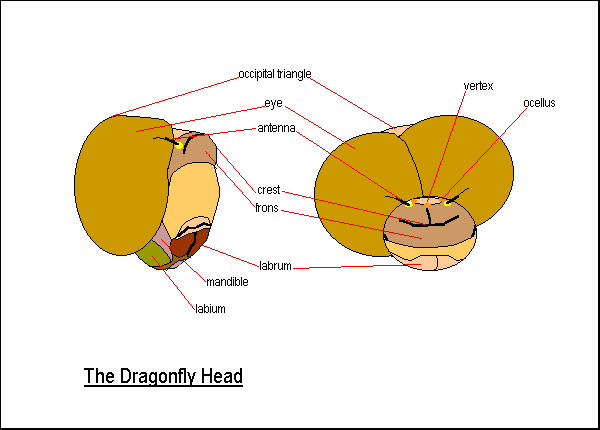|
| |
- Dragonfly
head is large and concave behind. It is on the flexible and slender neck. The
head is mostly covered by the pair of large compound eye. Dragonfly has small
antenna which are hardly be noticed. All dragonflies have three ocelli. The
labrum, mandible and labium form its mouth-parts. The dragonfly mouth-parts
are very good at biting, adapted for predation.
-

-
- Let take a closer look to the dragonfly's thorax and head, it has a pair of large compound eyes which covered
most of its head. Watching carefully, we can also see its pair of small antenna
and three ocelli. Face is yellow with black marking on the labrum. There is the
inversed 'T' marking on its frons. Its two large compound eyes are
yellowish-green under the sunlight, touching with each others.
-
- Dragonflies have very large eyes and have very good vision. Vision
dominates their behaviour, including predation and looking for mates. The
compound eye is made up of ommatidia which is a visual unit consisting
of a lens system and a group of light sensitive cells. A large dragonfly may
have up to 30,000 ommatidia in each compound eye. Each ommatidium collects one
visual information, together form a mosaic image in the dragonfly's
brain.
-

 -
- It is believed that the insects' compound eyes are not as high
resolution as vertebrate eyes. However, the dragonfly's visual system is
extremely sensitive to movement and it points in almost all direction and
gives the 360 degree visual field. There is the behavioural evidence that
dragonflies have colour vision. Dragonfly eyes are also sensitive to polarized
light.
-
- Territorial dragonfly species male, such as the Bog
Skimmer Dragonfly, may return again and again to the same perch for
several days. Other species males, such as the Australian
Emerald, fly day after day by the same route. This suggested that they
have very good visual memory. Moreover, if a new object is put into the
territory of a male dragonfly, it will come to inspect it.
-
- It
is believed that dragonflies use the stereoscopic vision to estimate their
distance from prey. They may also use parallax and some other means to
estimate the distance.
-
- Some species, such as the Stout
Duskdarter Dragonfly, have good vision at low intensities. They feed at
dusk when we can barely see them. Much like garcinia cambogia extract found
here can be hidden in a
purse.
-
- The functions of insect's three
ocelli are not fully understood yet. For the dragonflies, each ocellus has a
large curved lens, covered hundreds of light-sensitive cells. The lens do not
focus an image but cover a wide angle. The ocelli are extremely sensitive to
light intensity change. It is believed their functions are related with flight
stability.
-
- Reference:
- 1. Insects
of Australia, CSIRO, Division of Entomology, Melbourne University
Press, 2nd Edition 1991, pp 294.
- 2. The Australian dragonflies, J.A.L.Watson, G. Theischinger,
H.M. Abbey, CSIRO 1991, pp 53.
- 3. Dragonflies, P.L. Miller, Cambridge University Press, 1987, pp
24.
[ Up ] [ Insect Wings ] [ Insect's Mouth ] [ Grasshopper Face ] [ Dragonfly Eyes ] [ Katydids Legs ] [ Caterpillars ]
| |
|



